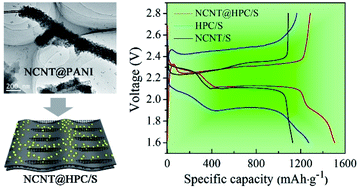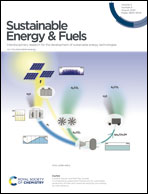Nitrogen-doped carbon nanotubes intertwined with porous carbon with enhanced cathode performance in lithium–sulfur batteries†
Abstract
Porous carbon structures are considered as desirable electrode materials for Li–S batteries due to their flexible texture, high surface areas, and good conductivities. However, polymer carbonized materials usually suffer from limited electrical conductivity that will finally restrain the battery's electrochemical performance. Herein, in this paper, polyaniline (PANI) hydrogels are firstly synthesized on a template of conductive N-doped carbon nanotubes (NCNTs) via a solution process. After carbonization and activation treatments, the composite materials reveal a highly porous carbon (HPC) structure interwound by NCNT wires, demonstrating a high specific surface area of 1861 m2 g−1 and a high electrical conductivity. After further incorporation of elemental sulfur, the resultant NCNTs@HPC/S cathode exhibits excellent electrochemical properties with a superior initial capacity of 1506 mA h g−1 at 0.2C, a stable capacity of 613 mA h g−1 after 250 cycles, and an obviously improved rate performance. This work suggests a feasible and efficient approach to fabricate carbon-based high-performance Li–S battery cathodes.



 Please wait while we load your content...
Please wait while we load your content...